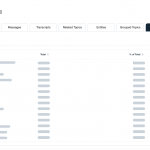Agent Wellbeing: Flexibility Is About More Than Where an Agent Works
Agent Wellbeing: Flexibility Is About More Than Where an Agent Works

With the increased digitalization of contact centers, there has been a growing need for workplace flexibility to respond quickly to changes in the workplace. This essential strategy continues to help leaders preserve and strengthen customer satisfaction, contact center operations, and agent wellbeing during times of great upheaval.
In modern call centers, more and more employees are working remotely or in a hybrid state. While agents are craving the improved work/life balance that remote work provides them, this creates new challenges for call center leaders trying to ensure agents stay engaged. It has also led to some conflict with leaders trying to force agents to return to working primarily in physical contact centers.
So, how can you continue to meet your call center’s objectives and exceed customer expectations while preventing agent attrition? Continue reading to explore ways to improve agent wellbeing in the modern contact center.
5 Ways to Increase Workplace Flexibility
Flexibility in the workplace means being flexible about how and when agents work. It’s the only way to retain the employees you have and attract the ones you need. There needs to be significant improvements made to help combat the Great Resignation occurring in the workplace.
Thankfully, there are several great ways to help support your team and improve your overall workforce wellbeing.
1. Incorporate the Concept of Flexibility
Your entire management team needs to wholeheartedly embrace flexibility. That might be easier for some managers who may already advocate for employee wellbeing. But, these managers probably don’t comprise all, or even a majority, of your entire management team.
You’ll need to lead by example and guide the rest to step out of their comfort zones, constantly rethinking what flexibility means to your agents. A great way to do this is by encouraging managers and supervisors to constantly ask questions, including:
- Are we accommodating our employees?
- Are we giving our agents the benefit of the doubt when it comes to problematic scenarios?
- Does it make more sense in this scenario to fire the customer instead of the agent?
Embodying the concept of flexibility will greatly improve your management style and improve the mental and physical wellbeing of your team.

3. Make Agent Schedules Even More Flexible
The need for increasingly flexible work schedules is a primary concern for many employees. There are many varying factors that determine an agent’s ideal schedule, including lifestyle preferences, family dynamics, and other personal factors. Fortunately, aside from labor laws, there aren’t any rules regarding what you can and cannot do when it comes to contact center scheduling.
By letting your agents make their own schedules, you can help reduce stress and increase agent wellbeing. Some benefits of self-scheduling include:
- Swap shifts
- Schedule breaks
- Flexible start times
- Easily apply for overtime
- Sign off early
- Take voluntary time
Another great feature of self-scheduling systems is that it lets agents sign up for split shifts, or even micro-shifts. These shifts are where agents choose to work in 30-minute increments. The best part is that they can do all of it online in an easy, intuitive and self-service manner.
4. Schedule Mandatory Rest into Each Day
With growing consumer needs, agent turnover and numerous other technical challenges, contact center employees are feeling more pressure than ever. It can feel cyclical with tired agents helping tired customers and having hardly any time to rest in between. By measuring key performance indicators (JPIs), you can get an idea of how your agents are doing.
These metrics help managers, like yourself, find ways to better balance your employee’s workload, find training opportunities and help build in mandatory breaks throughout to improve employee health and wellbeing. You’ll also get a more comprehensive look into how your contact center is performing. Finally, you’ll be able to build a more holistic business strategy to manage agent stress.
Given how unpredictable life can be, it’s important to remember that breaks will look different for everyone. In today’s world, a break could represent time spent exercising, caring for children, or even meditating in between work-related activities.
4. Use Channel Shift to Support Flexible Schedule
Calculating the occupancy rate of your contact center is a great way to discover how often agents are engaged in work-related activities. This percentage will help you discover periods throughout the day that experience heavy call volumes. By tracking the occupancy rate along with other essential KPIs, you can see when you need increased support. For example, a call center with an occupancy rate over 95% is having too many calls for each agent with little downtime in between to decompress. This could lead to fatigued agents or even a high turnover rate.
A great way to help support your team is by incorporating more omnichannel communications, including chat, email and SMS. These features help during staffing shortages to get consumers the right help, faster and more efficiently. That means that there will be a decrease in callbacks, long handle times and an increase in general employee and customer satisfaction.
5. Upgrade to a Cloud-Based Contact Center
One of the first things to consider for improving agent wellbeing is upgrading to a cloud-based contact center (if you haven’t already). There are several key benefits of moving to the cloud. Your agents will feel more supported and be able to access tools they need to do their jobs from anywhere, at any time.
Plus, your contact center managers will have the autonomy to effectively manage agents they no longer see in person. Some ways they can do so include:
- Screen recording
- Desktop and speech analytics
- Call recording
- Self-scheduling tools to empower agents
All of these tools can help unlock agent satisfaction by supporting unique work schedules and structural needs.

Boost Agent Wellbeing with Greater Flexibility
Workplace flexibility is a lot more than where an agent works; it’s how an agent works. In an ever-changing world, employees need smart technology and holistic business strategy that offers flexibility, understanding and support. By prioritizing agent wellbeing in contact centers, you will see an increase in engaged employees who feel empowered and invigorated. See how you can include some of the key strategies for improving agent wellbeing above for greater employee engagement and increase mental and physical wellbeing.
Don’t stop there! Read Calabrio’s latest report, “Health of the Contact Center: Agent Wellbeing & the Great Resignation” to get more insight into how agents are feeling and ways to help revitalize your team.









